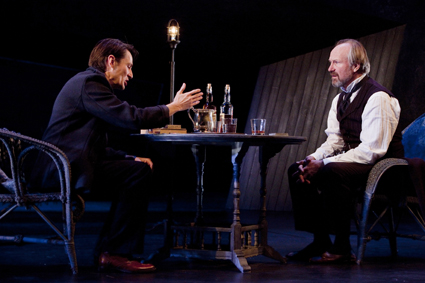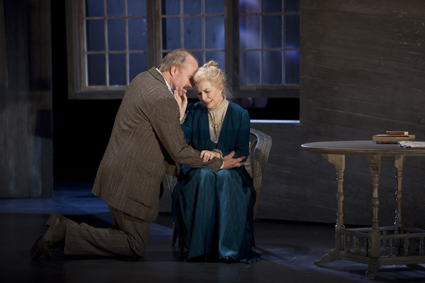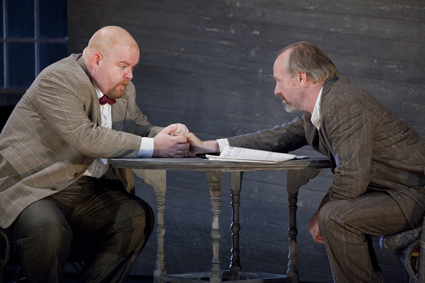 |
Luke Mullins, William Hurt, Long Day’s Journey Into Night, Sydney Theatre Company and Artists Repertory Theatre photo Brett Boardman |
 |
William Hurt, Robyn Nevin, Long Day’s Journey Into Night, Sydney Theatre Company and Artists Repertory Theatre photo Brett Boardman |
 |
Todd Van Voris, William Hurt, Long Day’s Journey Into Night, Sydney Theatre Company and Artists Repertory Theatre photo Brett Boardman |
O’Neill’s largely autobiographical play, written in 1942 but first published three years after his death in 1956, and in 1957 awarded the Pulitzer Prize for Drama, registers—with durational monumentality—the slow rising of an evil that is both soft and beautiful: a family addicted variously to morphine, whiskey, money and women, but also to their own familial dynamics of intense rage and love. Resurrected by Sydney Theatre Company, directed by Andrew Upton and featuring William Hurt and Robyn Nevin, the work enacts a three-and-a-half hour durée that witnesses both authorial lament and exorcism. The text’s demons are profound; its unfolding excruciating.
Alongside the much younger Tennessee Williams and Arthur Miller, O’Neill has been credited with rendering American realism “true” by realising the gritty vernacular of characters struggling on the edges of institutions, families and themselves: their gestural and vocal rhythms, their cyclical obsessions, their fatalistic bodily and moral corruptions. Edmund (presumed to be the young O’Neill, played by Luke Mullins) is suffering from consumption, a secret he hides from his wretchedly deluded (and morphine-addicted) mother Mary (Nevin). His father James (Hurt) and brother James Jnr (Todd Van Voris) endlessly bait each other and Edmund in rehearsals of contempt and betrayal, in contests over money lost and bitter memories. As in any family, these are set pieces, but here the Tyrones are caught in the thickness of their self-interest over self-effacement, drowning themselves in whiskey to soothe and then re-provoke.
The production design and dramaturgy works, on all levels, to preserve the play’s historicity—its reimagining of the American dream was as much dramaturgical and stylistic as it was philosophical. In this respect, the text’s familial ghosts feel uncomfortably trapped by theatrical and literary ghosts of form instead of being offered a contemporary opening out of the play’s emotional and textural scope. The set (Michael Scott-Mitchell) reads as a truthful replica of modernist architecture, but gives no cue to its reality as a contemporary refashioning of an old idea; there is no self-reflexivity in this kind of resurrection. The house is angular and partial, often swathed in blue light, sinking (or so it feels) amidst the punctuating sound of fog horns (Max Lyandvert), which are moody, but also equally cloyingly illustrative.
The performances cadence to different registers, and each are acts of exceptional mental endurance despite occasional lapses of rhythm when in concert with one another. Hurt’s paternalism is contained and powerful in his quiet (possibly too quiet for some) burning rage, and focuses steadfastly to find a sturdy andante delivery for words that need—with their particular vernacular poetics—to be able to out-perform his own celebrity presence. Nevin’s Mary is jittery and birdlike, a vista of a too-archetypal feminine anti-heroine, irritatingly caught in the image of her own trappings (and those of the era). Mullins and Van Voris are both robust in their delivery; Edmund coughs his chest onto the stage in an arc to slow death, James smothers his boisterous cynicism with the fuzz and fog of drink.
The meta-literary references within the play, such as those by Baudelaire (and countless others), portend the great literary legacy that O’Neill was himself to leave, long after he escaped the family hellhole, and even longer after his death. He dedicates the work to his third wife Carlotta as “a play of old sorrow, written in tears and blood,” with a 25 year moratorium on its production. With the past so strongly haunting the presence of this work, STC’s production is at once compelling and awkward, an incomplete conception of what it is to give due credit to a masterful work that is being experienced in a very different time. There was a certain sense of slow torture in waiting for the play’s death throes to abate, but this was not, I imagine, unlike O’Neill’s own experience of growing up. In this respect, sitting through the long night’s journey into day felt important, possibly rewarding.
Sydney Theatre Company, Long Day’s Journey into Night, writer Eugene O’Neill, director Andrew Upton, actors William Hurt, Robyn Nevin, Todd Van Voris, Luke Mullins, Emily Russell, design Michael Scott-Mitchell, sound Max Lyandvert, costumes Tess Schofield, lighting Nick Schlieper, Sydney Theatre, July 3-Aug 1
RealTime issue #98 Aug-Sept 2010 pg. 14
© Bryoni Trezise; for permission to reproduce apply to [email protected]








 back
back